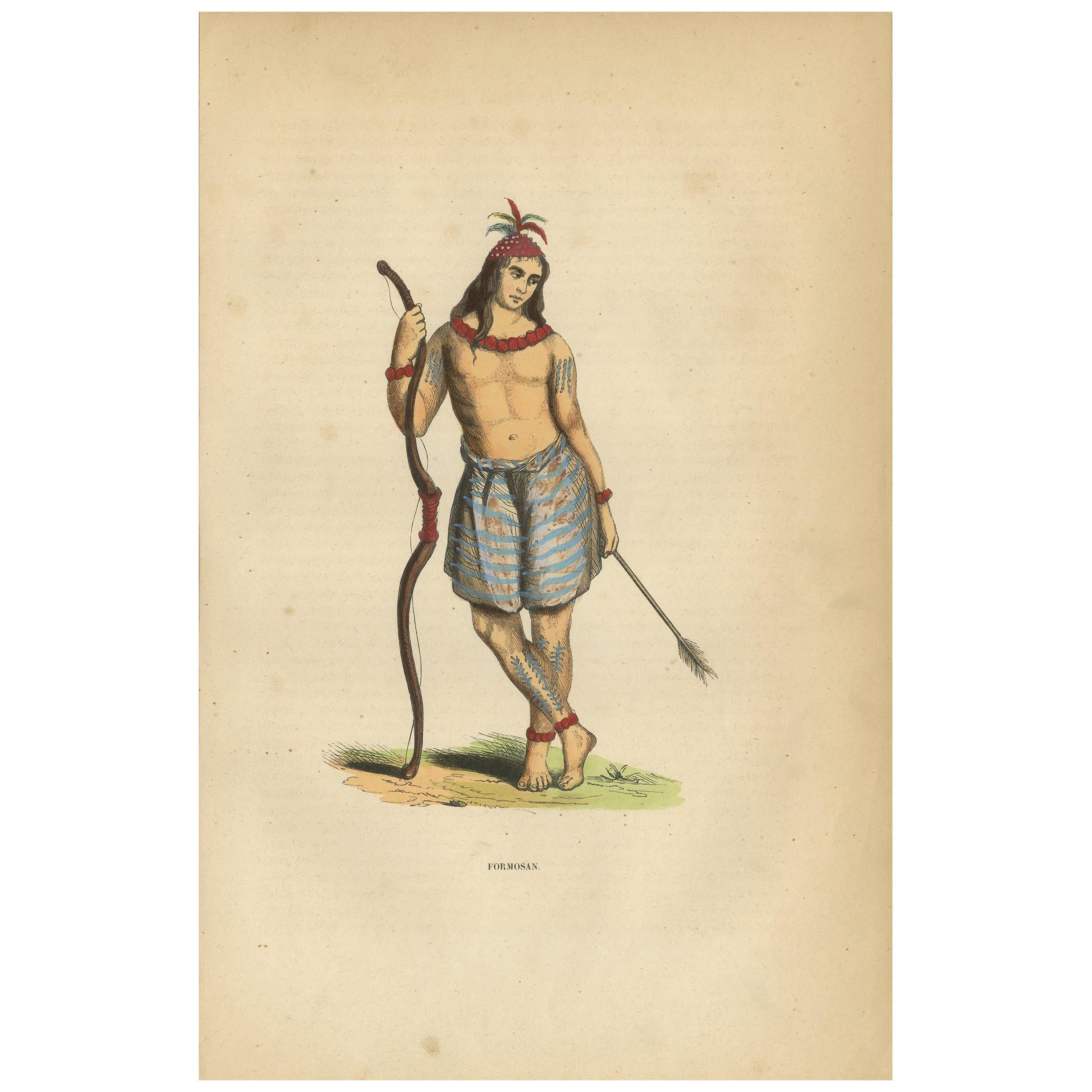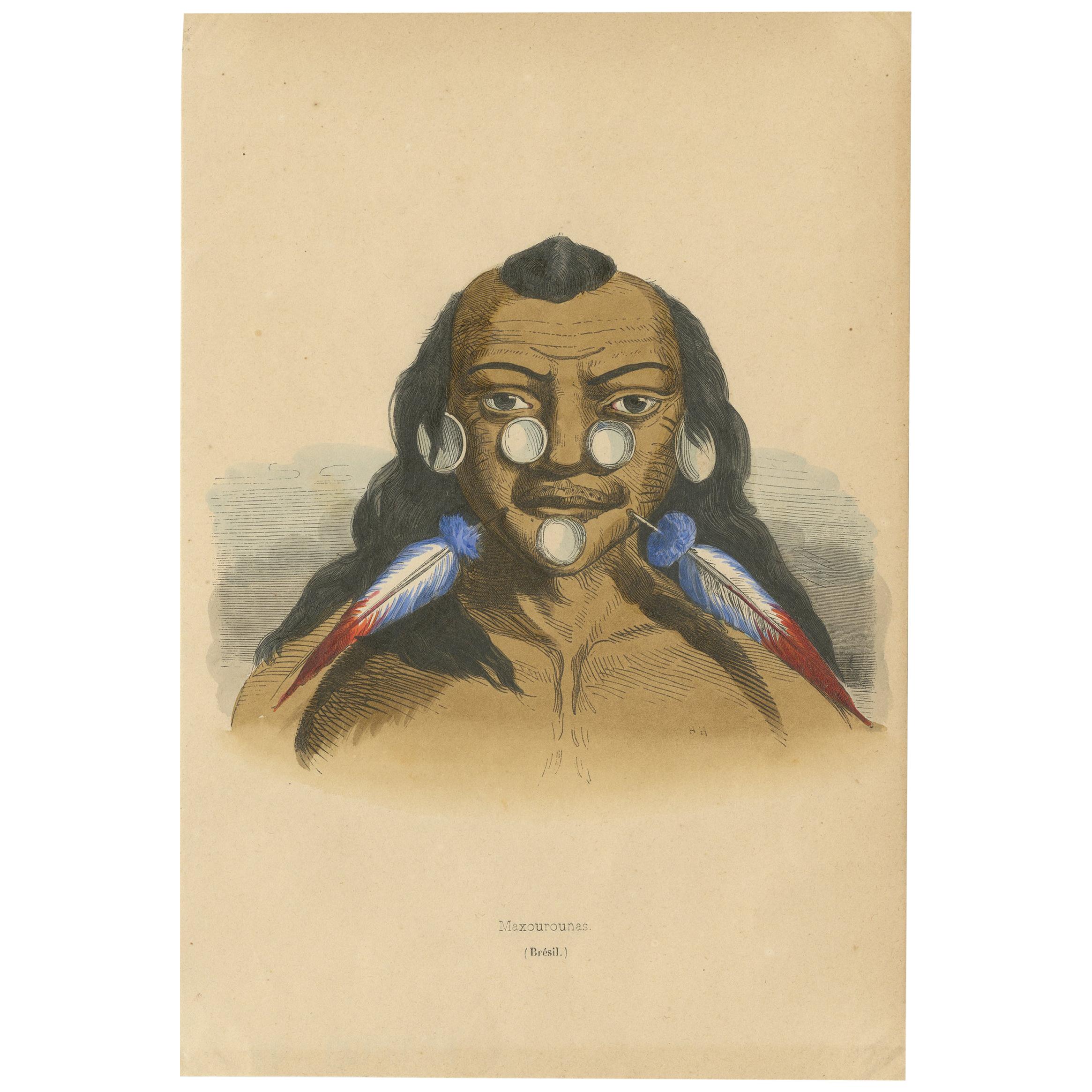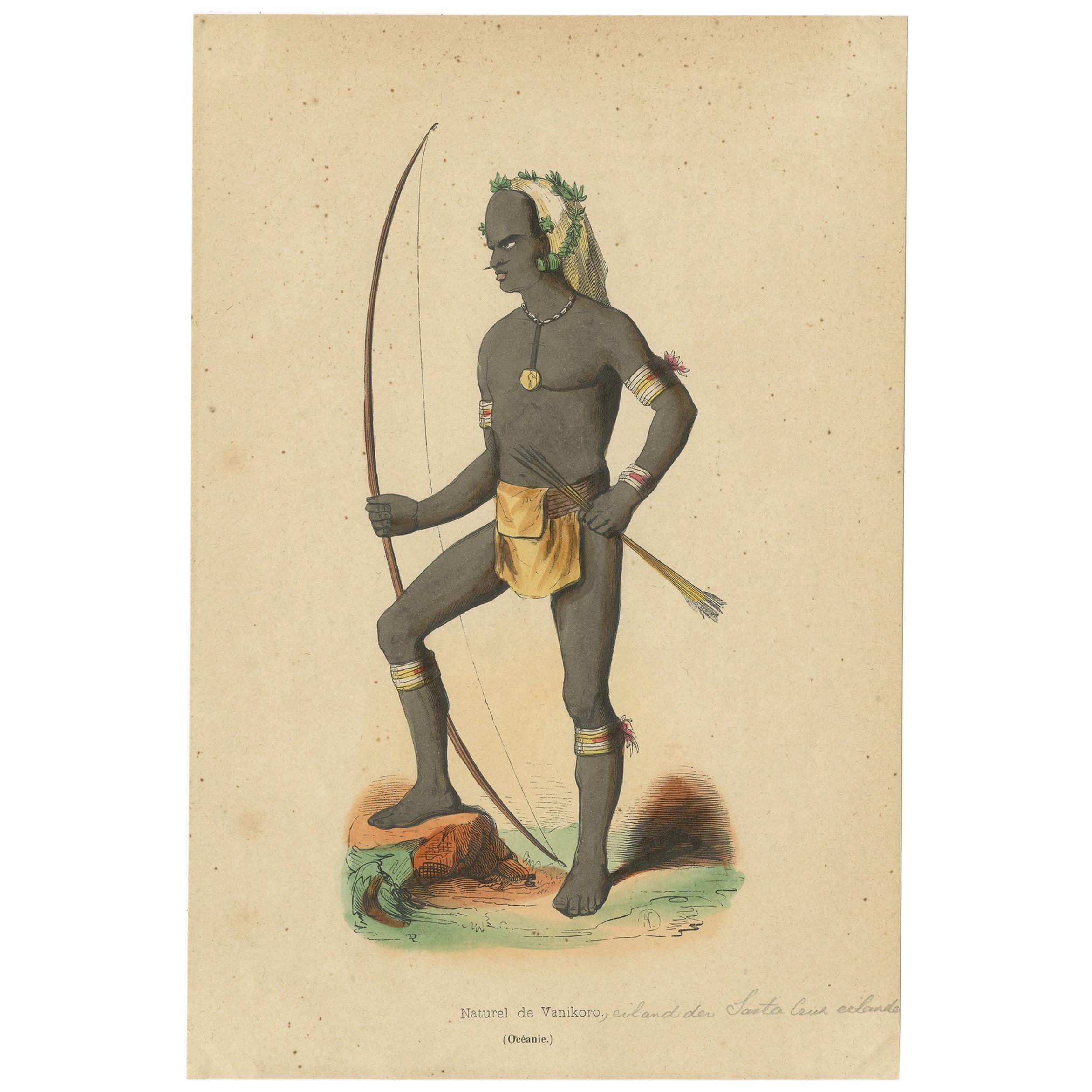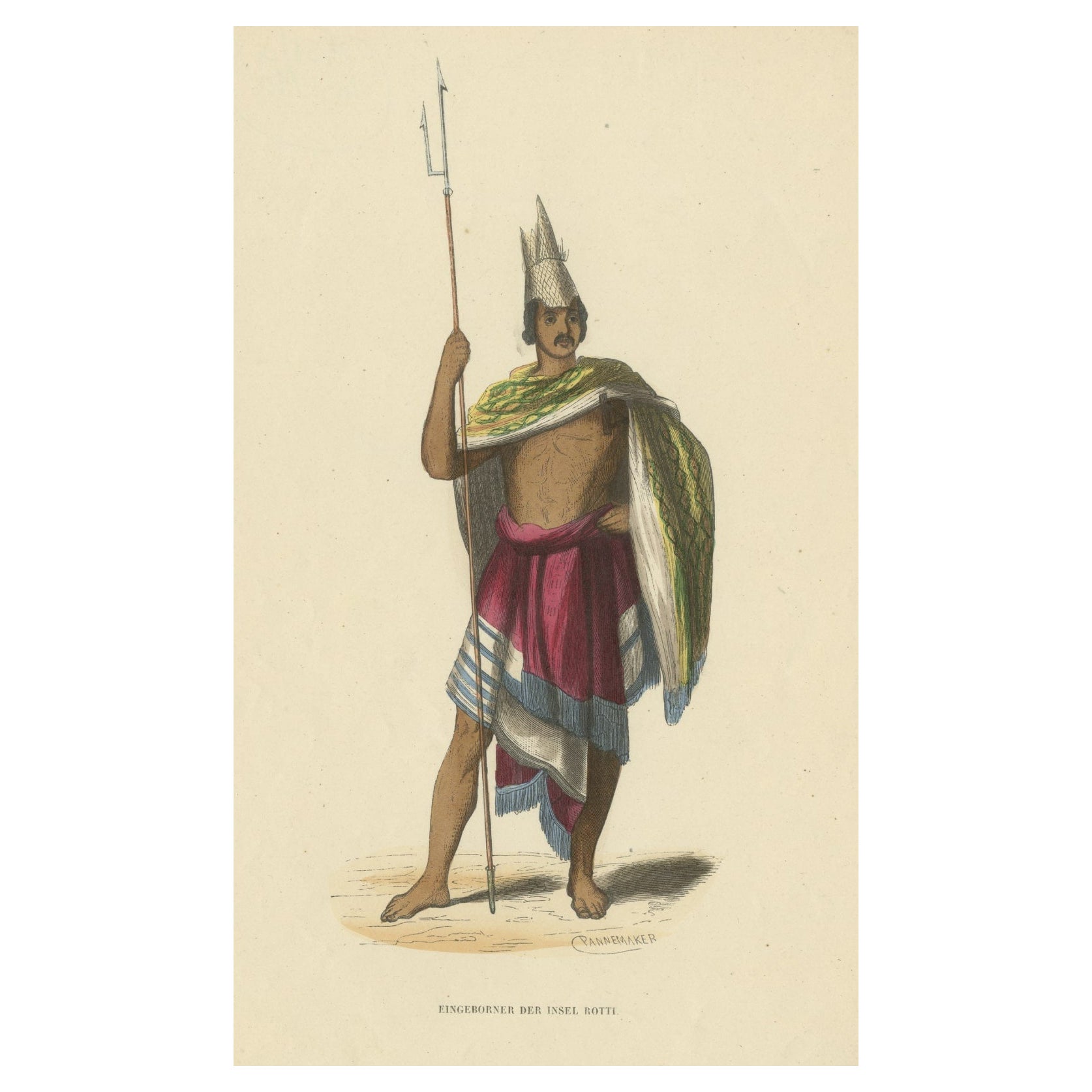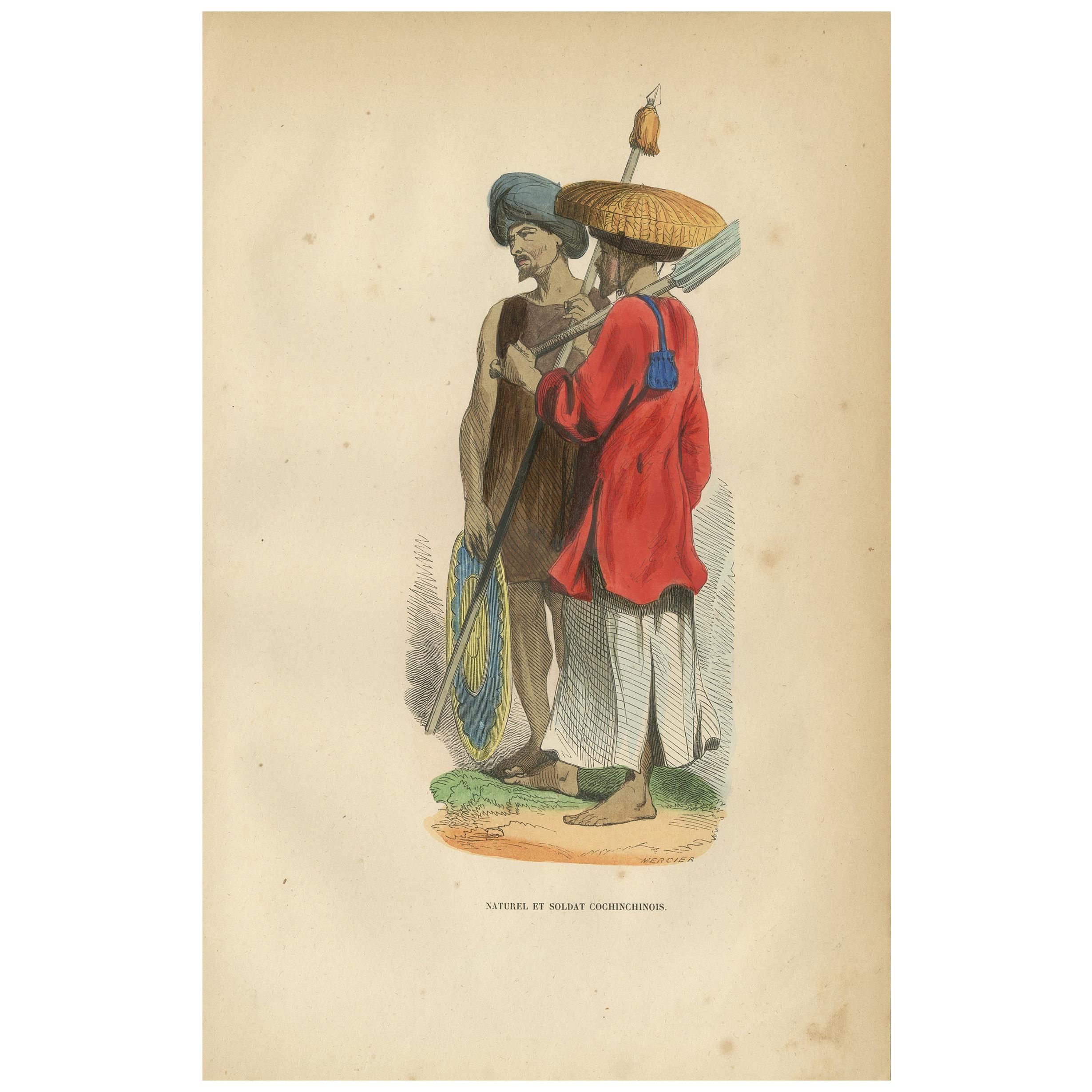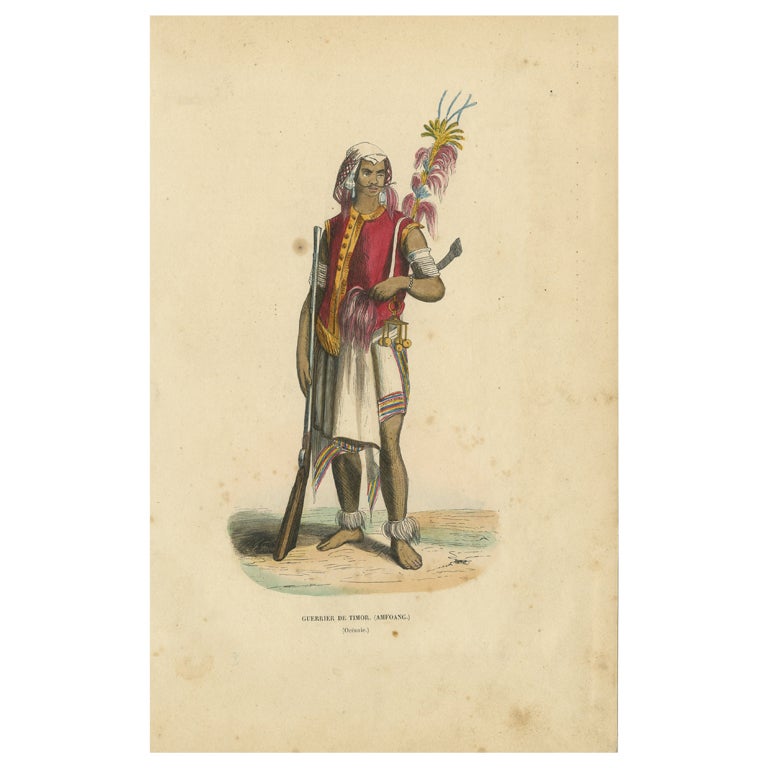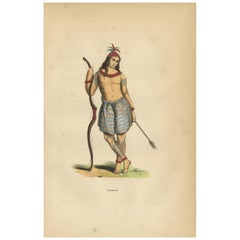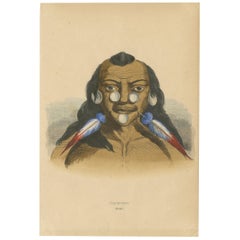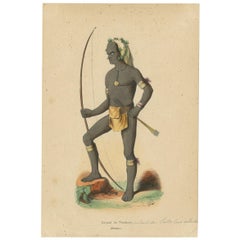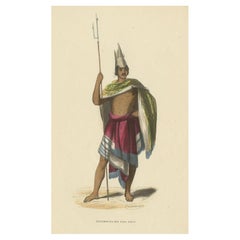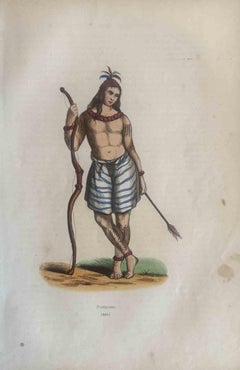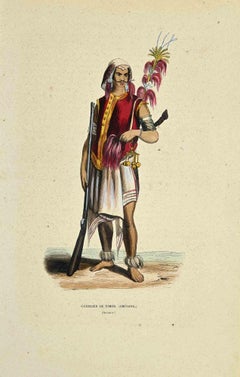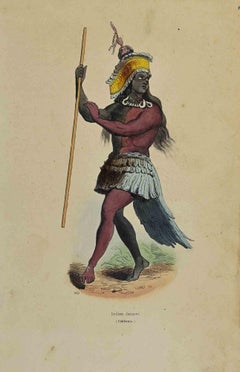Items Similar to Striking 1844 Lithograph of a Formosan (Taiwanese) Warrior in Traditional Attire
Want more images or videos?
Request additional images or videos from the seller
1 of 6
Striking 1844 Lithograph of a Formosan (Taiwanese) Warrior in Traditional Attire
$198.42
$248.0220% Off
£149.38
£186.7220% Off
€168
€21020% Off
CA$273.33
CA$341.6720% Off
A$306.12
A$382.6420% Off
CHF 159.73
CHF 199.6620% Off
MX$3,739.07
MX$4,673.8420% Off
NOK 2,032.18
NOK 2,540.2320% Off
SEK 1,915.58
SEK 2,394.4720% Off
DKK 1,278.84
DKK 1,598.5520% Off
About the Item
Title: "Striking 1844 Lithograph of a Formosan Warrior in Traditional Attire"
This print is a handcolored lithograph from the "Moeurs, Usages et Costumes de tous les Peuples de Monde," by Auguste Wahlen, published in 1844. It features a Formosan warrior, showcasing traditional attire and tattoos, highlighting the rich cultural heritage and detailed dress of the indigenous peoples of Formosa (modern-day Taiwan).
The lithograph is enriched with vibrant colors applied by hand, which not only captures the intricate details of the attire and tattoos but also enhances the print's aesthetic appeal and historical value.
The print titled "Formosan" from Auguste Wahlen's collection presents a fascinating glimpse into the attire and cultural symbols of the indigenous peoples of Formosa, known today as Taiwan. Here are a few interesting facts about the context and details of such prints:
1. **Cultural Representation**: The detailed depiction of the warrior’s attire and tattoos reflects the traditional dress and body art that were prevalent among certain tribes in Taiwan. These elements were not merely decorative but held significant cultural and spiritual meanings, often indicating status, achievements, and community roles.
2. **Historical Context**: The mid-19th century, when this print was published, was a period of intense curiosity in Europe about foreign cultures. Works like Wahlen's were highly popular as they offered a glimpse into the diverse customs and lifestyles around the world, feeding into the European imagination and fascination with the "exotic".
3. **Lithography Technique**: This print is an excellent example of handcolored lithography, a technique that was revolutionary at the time for its ability to produce more detailed and affordable images compared to earlier printmaking methods. This technology democratized access to such illustrations, making them available to a broader audience.
4. **Ethnographic Interest**: Prints like these are valuable not only for their artistic merit but also for their ethnographic significance. They serve as historical records of how people from various cultures were perceived and presented to the Western world during the 19th century.
These aspects make the print not only a beautiful piece of art but also a rich document of historical and cultural insights.
This artwork draws interest due to its rarity, craftsmanship, and depiction of a culture that has undergone significant changes over time.
Collectors might search for this print using keywords like "antique Formosan lithograph," "handcolored tribal warrior prints," and "vintage ethnic costume illustrations."
- Dimensions:Height: 10.12 in (25.7 cm)Width: 6.7 in (17 cm)Depth: 0 in (0.02 mm)
- Materials and Techniques:
- Period:
- Date of Manufacture:1844
- Condition:Condition: Good, given age. Faintly browned, and with some small stains. Some glue remains (from binding) in the far left margin (not affecting image). General age-related toning and/or occasional minor defects from handling. Please study the scans.
- Seller Location:Langweer, NL
- Reference Number:Seller: BG-12722-131stDibs: LU3054341389382
About the Seller
5.0
Recognized Seller
These prestigious sellers are industry leaders and represent the highest echelon for item quality and design.
Platinum Seller
Premium sellers with a 4.7+ rating and 24-hour response times
Established in 2009
1stDibs seller since 2017
2,533 sales on 1stDibs
Typical response time: <1 hour
- ShippingRetrieving quote...Shipping from: Langweer, Netherlands
- Return Policy
Authenticity Guarantee
In the unlikely event there’s an issue with an item’s authenticity, contact us within 1 year for a full refund. DetailsMoney-Back Guarantee
If your item is not as described, is damaged in transit, or does not arrive, contact us within 7 days for a full refund. Details24-Hour Cancellation
You have a 24-hour grace period in which to reconsider your purchase, with no questions asked.Vetted Professional Sellers
Our world-class sellers must adhere to strict standards for service and quality, maintaining the integrity of our listings.Price-Match Guarantee
If you find that a seller listed the same item for a lower price elsewhere, we’ll match it.Trusted Global Delivery
Our best-in-class carrier network provides specialized shipping options worldwide, including custom delivery.More From This Seller
View AllAntique Print of an Inhabitant of Formosa by Wahlen '1843'
Located in Langweer, NL
Antique costume print titled 'Formosan'. Original antique print of an inhabitant of Formosa (Taiwan). This print originates from 'Moeurs, usages et costumes de tous les peuples du mo...
Category
Antique Mid-19th Century Prints
Materials
Paper
$94 Sale Price
20% Off
Antique Costume Print of a Brazilian Warrior by Wahlen, 1843
Located in Langweer, NL
Antique costume print titled 'Maxourounas'. Original antique print of a Brazilian warrior. This print originates from 'Moeurs, usages et costumes de tous les peuples du monde' by Aug...
Category
Antique Mid-19th Century Prints
Materials
Paper
$94 Sale Price
20% Off
Antique Costume Print of a Warrior of Vanikoro Island by Wahlen, 1843
Located in Langweer, NL
Antique costume print titled 'Naturel de Vanikoro'. Original antique print of a warrior of Vanikoro Island. This print originates from 'Moeurs, usages et costumes de tous les peuples...
Category
Antique Mid-19th Century Prints
Materials
Paper
$94 Sale Price
20% Off
Antique Print of a Warrior from Roti or Rotti Island in East Indonesia, ca.1845
Located in Langweer, NL
Description: Antique print titled 'Eingeborner der Insel Rotti'.
Original antique print of an inhabitant of Rote Island, Indonesia. This print originates from 'Die Volker des Erd...
Category
Antique 1840s Prints
Materials
Paper
$151 Sale Price
20% Off
Antique Print of a Native and Soldier of Cochinchina by Wahlen, '1843'
Located in Langweer, NL
Antique costume print titled 'Naturel et Soldat Cochinchinois'. Original antique print of a native and soldier of Cochinchina. This print originates from 'Moeurs, usages et costumes ...
Category
Antique Mid-19th Century Prints
Materials
Paper
$94 Sale Price
20% Off
"Warrior of Timor: A Handcolored Glimpse into Indonesian Culture, 1845
Located in Langweer, NL
This antique print, titled 'Guerrier de Timor (Amfoang),' provides a vivid portrayal of an Atoni warrior from Kupang, West Timor, Indonesia. The hand-colored woodcut captures intrica...
Category
Antique Mid-19th Century Prints
Materials
Paper
$170 Sale Price
20% Off
Free Shipping
You May Also Like
Uses and Customs - Asian - Lithograph - 1862
Located in Roma, IT
Uses and Customs - Asian is a lithograph on paper realized in 1862.
The artwork belongs to the Suite Uses and customs of all the peoples of the universe: " History of the government...
Category
1860s Modern Figurative Prints
Materials
Lithograph
Guerrier de Timor - Lithograph by Auguste Wahlen - 1844
Located in Roma, IT
Guerrier de Timor is a hand colored lithographs realized by Auguste Wahlen in 1844.
Good conditions.
The artwork belongsto the Suite Moeurs, usages et costumes de tous les peuples ...
Category
1840s Modern Figurative Prints
Materials
Lithograph
Tah-Ro-Hon, An Ioway Warrior: Original Hand-colored McKenney & Hall Lithograph
By McKenney & Hall
Located in Alamo, CA
This is an original 19th century hand-colored McKenney and Hall lithograph of a Native American entitled "Tah-Ro-Hon, An Ioway Warrior", lithographed by J. T. Bowen after a painting by Charles Bird King and published by Rice and Hart & Co. in Philadelphia in 1848. For his portrait Tah-Ro-Hon is wearing a feathered multicolored headdress, long ornamental earrings, a chain necklace, a presidential piece medal on a ribbon necklace and he holds a multicolored staff with feathers.
This original McKenney and Hall hand-colored lithograph is printed on a sheet measuring 10" high and 7" wide. There is a tiny spot of red paint adjacent to a red feather hanging...
Category
Mid-19th Century Naturalistic Portrait Prints
Materials
Lithograph
Indien Dansant - Lithograph by Auguste Wahlen - 1844
Located in Roma, IT
Indien Dansant is a hand colored lithographs realized by Auguste Wahlen in 1844.
Good conditions.
The artwork belongsto the Suite Moeurs, usages et costumes de tous les peuples du ...
Category
1840s Modern Figurative Prints
Materials
Lithograph
Japanese Soldier - Lithograph by Auguste Wahlen - 1844
Located in Roma, IT
Japanese Soldier is a lithograph made by Auguste Wahlen in 1844.
Hand colored.
Good condition.
At the center of the artwork is the original title "Soldat Japonais".
The work is p...
Category
1840s Modern Figurative Prints
Materials
Lithograph
Herault de Timor - Lithograph by Auguste Wahlen - 1844
Located in Roma, IT
Herault de Timor is a hand colored lithograph realized by Auguste Wahlen in 1844.
Good condition.
The artwork belongs to the Suite Moeurs, usages et costumes de tous les peuples du...
Category
1840s Modern Figurative Prints
Materials
Lithograph
More Ways To Browse
China Jade Tube
Chinese Bronze Horse
Chinese Camphor Wood Chest
Chinese Enamel Ginger Jars
Chinese Hardstone Carving
Chinese Jewelry Cabinet
Chinese Jewelry Cabinets
Chinese Wood Guanyin
Chinoiserie Teapot
Clothes Horse Antique
Coach Leather Furniture
Cobalt Blue Porcelain And Bronze Urn
Crab Claw
Crockery Cabinet
Crystal Cat Vintage
Danish 3 Chest Of Drawers
Danish Desk Organizer
Decorative Crafts Inc Brass
